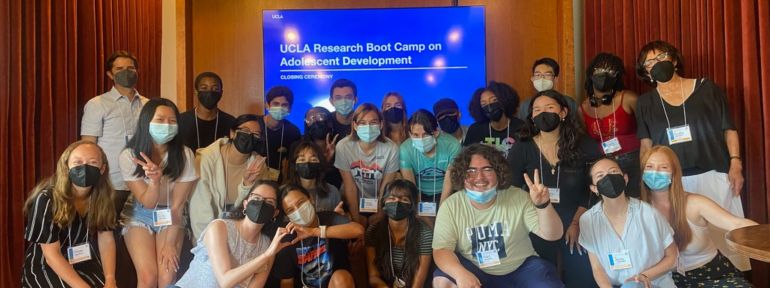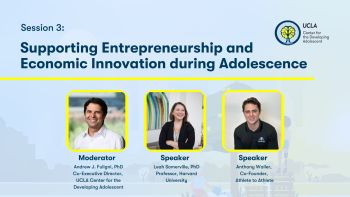This post was written by high school students from the Summer Research Boot Camp in the labs of Andrew Fuligni and Sandra Graham at UCLA, supported by UCLA Center for the Developing Adolescent, and led by Jenna Felkey, Piper Harris, Naomi Kline, and Xochitl Arlene Smola.
Authors: Ezekiel Ito, Ryan Jacob Levi, and Talya Soffer
Walking up the steps to the first day of Boot Camp after navigating the UCLA campus, we had no idea what to expect. The brief information packet we had received said we would learn about falling asleep, but we soon discovered that learning about it was anything but sleep-inducing. We learned the basics–from how our sleep cycles are regulated, to how they change among varying age groups. It was not just lectures either—most lessons were supplemented with real data and research that was presently being conducted, from correlational studies relating trauma with poor sleep quality to actually getting to hold real sheep brains.
The second week concerned relationships and their value. As a group, we defined what makes a friendship and discussed the qualities we seek in friends. From there, we had an in-depth discussion of what might cause these wants—a desire for trust could be motivated by a need for security and assurance. We also learned that many tend to have friends similar to them—particularly in race—and those who are easily accessible, and we realized that most friend groups at our school are fairly homogenous with maybe one or two of another race.
More interesting was the research about the effects of diverse relationships. Studies revealed that those with more diverse friendships display greater empathy and better academic performance. This correlation doesn’t stop in high school either; a study has shown that diverse juries spend more time discussing a case and tend to arrive at a conclusion closer to the presented information than all-White juries.
Knowing this, great action needs to be taken to encourage diverse environments. While schools tend to display some diversity across their populations, they fall short in maintaining this in the classroom environment, where most students make most of their friends (due to the tendency to make friends with people easily accessible to them).
At the end of the camp, everybody worked on proposals to help fix one problem, from sleep deprivation in high schoolers to limited diversity in classrooms. Using various datasets and everything we had learned, we came up with solutions. While our solutions were subject to flaws—if it were this simple, they would have already been in place—the process made us consider what is required to fix the issues we see today. One proposal—a later school start time—has already been put in place across California, and has some demonstrated flaws. (For example, Ezekiel had to majorly adjust his ride schedule since it pushes his ride home straight into rush hour traffic, but he’s found it much easier to wake up 30 minutes later).
This experience has truly made us think about how important not only sleep and friendships are in our lives, but also how much everything around us is controlled by so many factors. Now, whenever we do or encounter something that seems strange, we have to ask ourselves, “what could have possibly led to this?”
Source: https://www.apa.org/pubs/journals/releases/psp-904597.pdf



